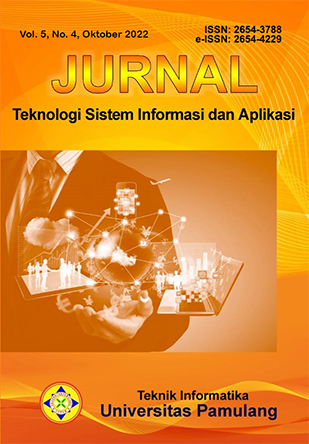Pengembangan Aplikasi Sistem Informasi Persediaan Barang Menggunakan Model Waterfall
Kata Kunci:
Persediaan, Metode, Waterfall, AplikasiAbstrak
Dalam suatu perusahaan sistem persediaan merupakan aspek yang sangat penting untuk kebutuhan persediaan yang akan digunakan oleh perusahaan. Dari hasil penelitian yang telah dijalani oleh kelompok 7 pemeriksaan persediaan material dilakukan secara manual, sehingga dari masalah tersebut diperlukan suatu teknologi informasi untuk pemeriksaan suatu persediaan. Dalam mengembangkan suatu teknologi informasi persediaan barang, kami akan menggunakan metode waterfall. Dalam hasil percobaan ditemukan bahwa model waterfall dapat dikembangkan untuk membangun sistem teknologi informasi persediaan barang yang dapat meningkatkan kinerja karyawan dan mempermudah perusahaan dalam membantu perusahaan untuk meningkatkan penjualan. Untuk mengetahui layak atau tidaknya suatu aplikasi melakukan uji kelayakan pada suatu perusahaan dengan menggunakan ISO 9145-3 dan hasil dari evaluasi diperoleh, Kemudahan dalam mempelajari sebesar 78%, Kemudahan dalam mengakses program sebesar 85% dan kesesuaian dalam tujuan sebesar 89%, kemudahan yang dapat dipahami sebesar 83%
Referensi
A. Rachman, B. E. Prasetyo, R. Arief, and M. A. Ferdiansyah, “Pengembangan Aplikasi Game Pembelajaran Matematika ‘ Momon Math Run ’ Berbasis Desktop Menggunakan Model Waterfall,†Semin. Nas. Sains dan Teknol. Terap. VII 2019, pp. 433–438, 2019.
A. Zahir, “Pengembangan Media Pembelajaran Live Streaming Pengetahuan Komputer Berbasis Website,†J. Ilm. d’COMPUTARE, vol. 9, no. 2, pp. 1–7, 2020.
E. Khikmawati, M. Anggraini, and K. Anwar, “Analisis Perencanaan Biaya Persediaan Produk Semen Melalui Pendekatan Perencanaan Kebutuhan Bahan Baku (Material Requirement Planning),†J. Rekayasa, Teknol. dan Sains, vol. 1, no. 1, 2017.
E. S. Soegoto, “Implementing Laravel framework website as brand image in higher-education institution,†in IOP Conference Series: Materials Science and Engineering, 2018, vol. 407, no. 1, p. 12066.
F. Sonata, “Pemanfaatan UML (Unified Modeling Language) Dalam Perancangan Sistem Informasi E- Commerce Jenis Customer-To-Customer,†J. Komunika J. Komunikasi, Media dan Inform., vol. 8, no. 1, pp. 22– 31, 2019.
I. Ananda and E. Zuraidah, “Perancangan Sistem Informasi Penjualan Barang Pada PT Asia Truk Pratama Jakarta,†J. Inform., vol. 6, no. 2, pp. 193–200, 2019.
M. Fadly, D. Suhendro, and A. Syahputra, “Perancangan Aplikasi Persediaan Barang dan Bahan Makanan Menggunakan Metode FIFO pada KFC Pematangsiantar,†J. Ilm. Media Sisfo, vol. 13, no. 1, p. 48, 2019, doi: 10.33998/mediasisfo.2019.13.1.527.
N. Tamsir and K. Alloto’dang, “Perancangan Aplikasi Manajemen Aset Sekolah Berbasis Web Service Pada Dinas Pendidikan Provinsi Sulawesi Selatan,†in SISITI: Seminar Ilmiah Sistem Informasi dan Teknologi Informasi, 2019, vol. 8, no. 2.
O. J. Okesola, A. A. Adebiyi, A. A. Owoade, O. Adeaga, O. Adeyemi, and I. Odun-Ayo, “Software Requirement in Iterative SDLC Model,†in Computer Science On-line Conference, 2020, pp. 26–34.
R. Agustin, T. Informatika, F. Teknik, and U. N. Surabaya, “Perancangan Sistem Aplikasi Penyedia Jasa Rental Mobil Berbasis WEB( Studi Kasus : NUSA TRANS SURABAYA ) I Kadek Dwi Nuryana Abstrak,†2020.
S. Butsianto and P. Riyanti, “Penerapan Sistem Pakar Menggunakan Metode Forward Chaining untuk Deteksi Penyakit pada Kucing Anggora Berbasis Web,†J. SIGMA, vol. 9, no. 3, pp. 59–64, 2019.
T. Hidayat and M. Muttaqin, “Pengujian sistem informasi pendaftaran dan pembayaran wisuda online menggunakan black box testing dengan metode equivalence partitioning dan boundary value analysis,†2020.
F. Frieyadie and T. Setiyorini, “Implementation of Inventory Information System Design Using Economic Order Quantity Method,†J. Ris. Inform., vol. 3, no. 2, pp. 187–194, 2021.
M. Syarif and W. Nugraha, “Pemodelan Diagram UML Sistem Pembayaran Tunai Pada Transaksi E- Commerce,†J. Tek. Inform. Kaputama, vol. 4, no. 1, p. 70 halaman, 2020, [Online]. Available: http://jurnal.kaputama.ac.id/index.php/JTIK/article/view/240.
S. Mukaromah, A. Pratama, S. A. Ithriah, and A. B. Putra, “Analysis and design student entrepreneurship information system,†J. Phys. Conf. Ser., vol. 1569, p. 22045, 2020, doi: 10.1088/1742-6596/1569/2/022045.
Unduhan
Diterbitkan
Cara Mengutip
Terbitan
Bagian
Lisensi
Hak Cipta (c) 2022 Aries Saifudin, Andi Kusuma Saputra, Bagas Saputra, Fajrial Subhan, Fiqri Nanda Maulana, Irpan Kusyadi

Artikel ini berlisensi Creative Commons Attribution-NonCommercial 4.0 International License.
Authors who publish with this journal agree to the following terms:
- Authors retain copyright and grant the journal right of first publication with the work simultaneously licensed under a Creative Commons Attribution License that allows others to share the work with an acknowledgement of the work's authorship and initial publication in this journal.
- Authors are able to enter into separate, additional contractual arrangements for the non-exclusive distribution of the journal's published version of the work (e.g., post it to an institutional repository or publish it in a book), with an acknowledgement of its initial publication in this journal.
- Authors are permitted and encouraged to post their work online (e.g., in institutional repositories or on their website) prior to and during the submission process, as it can lead to productive exchanges, as well as earlier and greater citation of published work (See The Effect of Open Access).
Jurnal Teknologi Sistem Informasi dan Aplikasi have CC BY-NC or an equivalent license as the optimal license for the publication, distribution, use, and reuse of scholarly work.
In developing strategy and setting priorities, Jurnal Teknologi Sistem Informasi dan Aplikasi recognize that free access is better than priced access, libre access is better than free access, and libre under CC BY-NC or the equivalent is better than libre under more restrictive open licenses. We should achieve what we can when we can. We should not delay achieving free in order to achieve libre, and we should not stop with free when we can achieve libre.
This work is licensed under a Creative Commons Attribution-NonCommercial 4.0 International (CC BY-NC 4.0) License
YOU ARE FREE TO:
- Share - copy and redistribute the material in any medium or format
- Adapt - remix, transform, and build upon the material for any purpose, even commercially.
- The licensor cannot revoke these freedoms as long as you follow the license terms



_2020_-_7(2)_2024_-_Thumbnail.png)












